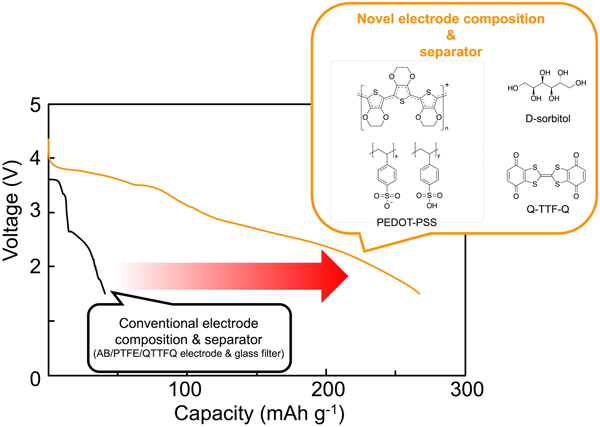Crossref Citations
This article has been cited by the following publications. This list is generated based on data provided by
Crossref.
Kato, Minami
Sano, Hikaru
Kiyobayashi, Tetsu
and
Yao, Masaru
2020.
Viologen Derivatives Extended with Aromatic Rings Acting as Negative Electrode Materials for Use in Rechargeable Molecular Ion Batteries.
ChemSusChem,
Vol. 13,
Issue. 9,
p.
2379.
Kato, Minami
Sano, Hikaru
Kiyobayashi, Tetsu
Takeichi, Nobuhiko
and
Yao, Masaru
2020.
Improvement of the Battery Performance of Indigo, an Organic Electrode Material, Using PEDOT/PSS with d-Sorbitol.
ACS Omega,
Vol. 5,
Issue. 30,
p.
18565.
Yao, Masaru
Taguchi, Noboru
Ando, Hisanori
Takeichi, Nobuhiko
and
Kiyobayashi, Tetsu
2020.
Improved gravimetric energy density and cycle life in organic lithium-ion batteries with naphthazarin-based electrode materials.
Communications Materials,
Vol. 1,
Issue. 1,
Misaki, Yohji
Noda, Shigenobu
Kato, Minami
Yamauchi, Tomokazu
Oshima, Toko
Yoshimura, Aya
Shirahata, Takashi
and
Yao, Masaru
2020.
Fused Tetrathiafulvalene and Benzoquinone Triads: Organic Positive‐Electrode Materials Based on a Dual Redox System.
ChemSusChem,
Vol. 13,
Issue. 9,
p.
2312.
Ito, Hiroshi
Murata, Tsuyoshi
Fujisaki, Megumi
Tsuji, Ryotaro
and
Morita, Yasushi
2021.
High Capacity and Energy Density Organic Lithium‐Ion Battery Based on Buckypaper with Stable π‐Radical.
ChemSusChem,
Vol. 14,
Issue. 5,
p.
1377.
Liu, Xiaobin
Gao, Zhenguo
Cheng, Jingcai
Gong, Junbo
and
Wang, Jingkang
2022.
Research progress on preparation and purification of fluorine-containing chemicals in lithium-ion batteries.
Chinese Journal of Chemical Engineering,
Vol. 41,
Issue. ,
p.
73.
Sano, Hikaru
Yoshimura, Aya
Zhang, Lei
Ebisawa, Haruki
Kiyokawa, Takeshi
Fujita, Koichi
Misaki, Yohji
and
Yao, Masaru
2024.
Cation-Independent Anion Battery Using Organic Cathodes Utilizing a Triphenylamine Moiety for In-Cell Electropolymerization.
ACS Applied Polymer Materials,
Vol. 6,
Issue. 13,
p.
7542.
Gopinadh, Sumol V.
Phanendra, Peddinti V. R. L.
V, Anoopkumar
John, Bibin
and
TD, Mercy
2024.
Progress, Challenges, and Perspectives on Alloy-Based Anode Materials for Lithium Ion Battery: A Mini-Review.
Energy & Fuels,
Vol. 38,
Issue. 18,
p.
17253.
